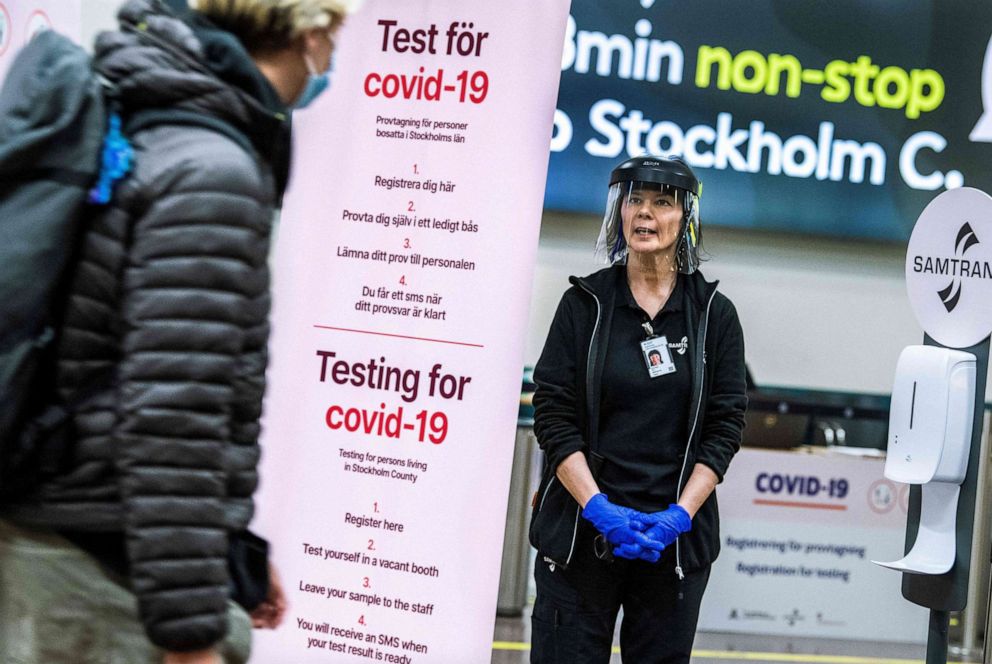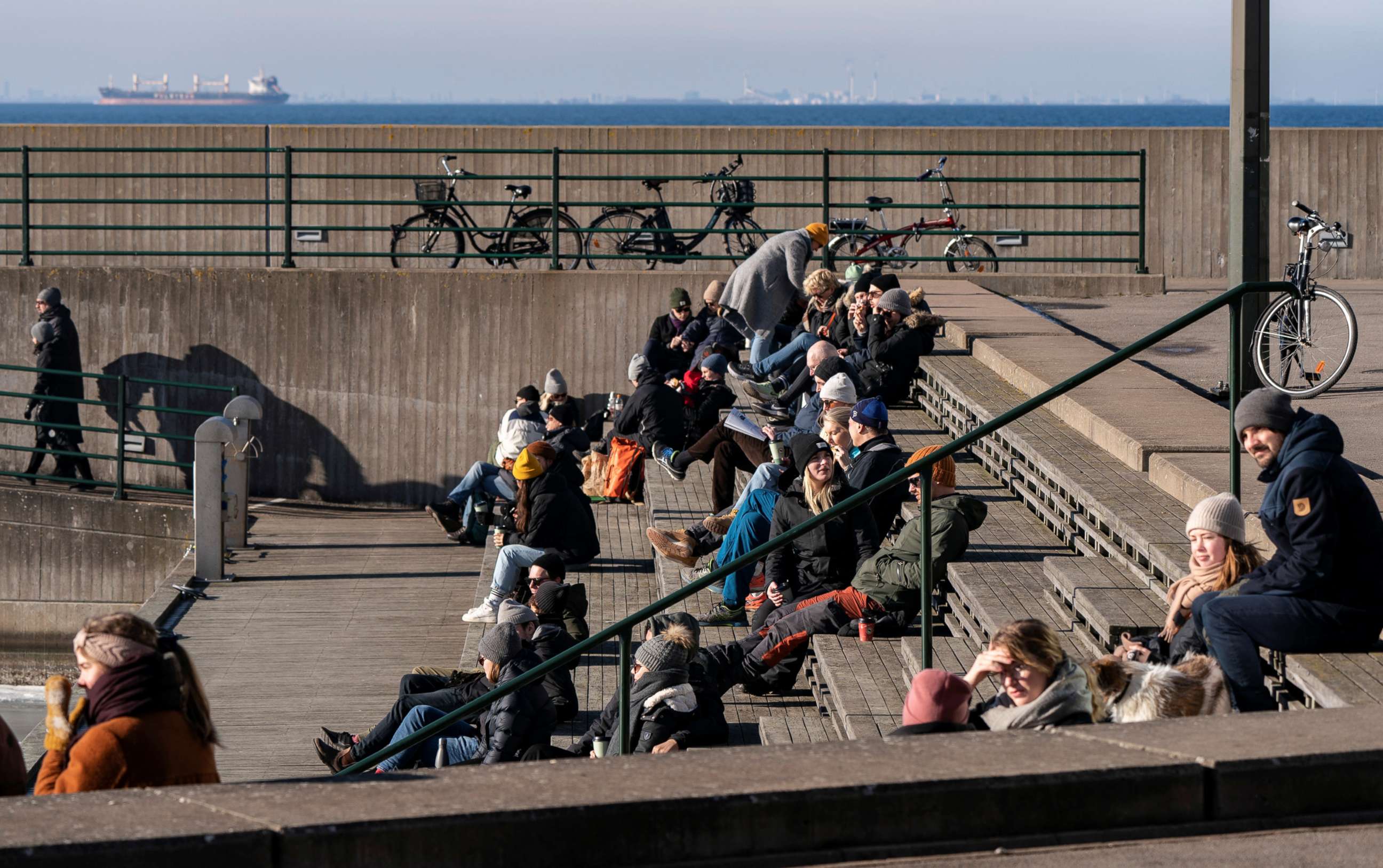Sweden has avoided a COVID-19 lockdown so far: Has its strategy worked?
The country is the only in Europe to avoid some kind of lockdown.
LONDON -- Sweden’s novel approach to tackling the coronavirus pandemic has drawn both praise and fierce criticism, not just inside the Scandinavian country, but across the Western world. The country has so far resisted going into lockdown, unlike the rest of Europe, even during the peak of its second wave over Christmas.
In doing so, Sweden has become a lightning rod for those in favor and against stricter social distancing measures. For some, its significantly higher COVID death rate compared to its neighbors is proof that lockdowns are essential to combat the spread, while for others, the comparative openness of Swedish society proves that a “balanced” approach to the pandemic is possible.
Now, a year into the pandemic, and with a vaccine rollout likely in the near future, their strategy continues to attract international attention. ABC News looked at the pitfalls and merits of their approach in May last year, and a year later, the evidence shows that now, as much as ever, their unique approach offers invaluable lessons to the international community for living in the long term with COVID-19.
The soft-touch approach

Denmark, Norway and Finland, with a combined population of around 16.75 million, have recorded 4,331 deaths attributed to coronavirus as of Thursday (259 per million). All three enforced lockdowns early on in the pandemic. Sweden, by contrast, has registered 12,798 deaths, and possesses a population 10.2 million, meaning it has a far higher death rate than its immediate neighbors (1,255 per million), according to Johns Hopkins University data.
For critics of the light touch approach, such as Stefan Hanson, a Swedish infectious diseases expert, such a high death rate is evidence of the failure of an overall strategy.
"The basic problem is there are no clear plans,” he told ABC News. “From the start, there never as have been. Normally when you run a public health project, you have some aims and strategies, you have some goals and you follow up, you have a monitoring system to see how things are going. But in the case of Sweden there has been nothing like that."
"It's all about having a low transmission. And Sweden hasn't put that forward as a very important thing,” he added. In April 2020, Hanson was co-signatory to a letter from several top Swedish scientists criticizing the approach to the pandemic, which they said would cause “many unnecessary deaths.”
Yet even throughout Europe’s "second wave," which saw Stockholm’s intensive care units almost run out of beds over the Christmas period, the country has resisted the temptation to lock down, being the only country in Europe to do so. December saw a very rare intervention from King Carl XVI Gustaf, who said the country had “failed” in its approach. The strategy, pioneered by Anders Tegnell, Sweden’s state epidemiologist, has been heavily criticized, not just at home, but abroad as well. False optimism that the capital, Stockholm, would reach "herd immunity" by fall has compounded that criticism.
Herd immunity occurs when there are enough people who have either been vaccinated or exposed to the virus that it can no longer spread in the population. Critics say that doing so by exposure to the virus creates unnecessary risk.
Yet as with so much of the data relating to COVID-19, proponents of the policy say that reading the data is a matter of perspective.
Sweden may be faring comparably better in terms of excess deaths -- those greater than the usual number of deaths expected in a certain time period. Experts say excess deaths can indicate whether policies intended to combat the pandemic have unintended consequences, such as delaying treatment for other ailments and is an important measure of the overall efficacy of policy.
While still performing worse than other Nordic countries on data from Eurostat, the official European Union statistics agency, and the University of Oxford, shows that Sweden recorded 7.9% excess deaths last year compared to the years 2016-19, according to the independent health news site Dagens Medicin.
That means that the country had the 23rd lowest annual excess deaths out of 30 European countries -- lower than the U.K. (15.1%), France (10.4%) and Spain (18.9%). Sweden also has a lower number of coronavirus deaths per million than those countries, all of which have gone under strict lockdowns during the pandemic. Pointing to the recent excess mortality studies, Nils Karlson, an economist and political scientist who jointly wrote an op-ed last year in Foreign Affairs entitled “Sweden’s Coronavirus Strategy Will Soon Be the World’s,” is more optimistic.
“There was some recent figures showing that if you count excess mortality, Sweden is one of the best countries in Europe,” he told ABC News. “And one of the reason is, of course, that we didn't get the flu, just the ordinary flu, because we wash our hands. We have social distancing. We didn't have as many car accidents. You know, all kinds of other stuff that that affects us didn't happen this year.”
The resistance to lockdown, he said, is based on the idea that they are “unsustainable,” he said, and Sweden’s strategy takes into account not just economic factors, but all aspects of public life. While acknowledges the COVID death toll was too high, he said: “You have to keep society open not only for economic reasons, but also for critical public functions to to function, like hospitals, schools and so on. Schools are still open for younger kids... Otherwise, it's remote learning. But I think it has worked fairly well.”

The care home crisis
One area where there has been consensus, however, is the crisis in the Swedish old age care sector, where the crisis has taken a terrible toll.
Care home residents have made up around half of the country’s total death toll, with a further quarter of the deaths being seen amongst over 70s who receive care at home.
“The big thing was that the whole pandemic we know that old people, like in old age care, were the people who were really the people who were mostly going to die and the people who mostly went to hospitals,” Ingmar Skoog, a Swedish psychiatrist who specializes in studying old age, told ABC News. “Despite that, they didn't take in any expert in old age.”
The Swedish government introduced more protective equipment and testing, as did other countries and restricted care home visits.
A government-appointed commission concluded in December that high rates of infection in the general population, as well as a fragmented administration which made it difficult to produce consistent policy, contributed to the crisis.
“We have found that elderly care was unprepared and ill-equipped when the pandemic struck and that this was founded in structural shortcomings that were known long before the outbreak of the virus,” the report said.
While it is “obvious” that higher rates of infection make it more likely for the virus to sweep through old age care homes, Skoog said, part of the problem has been a fundamental misunderstanding of the sheer number of person-to-person contacts those in care go through every single day.
“They meet a lot of people very intimately because, they get help with the clothing, maybe food, dressing, hygiene, going to the toilet and so on,” according to Skoog. “And people are very, very close. And that means that they meet a lot of younger people… I think one of the first things that really should have been done, was to talk with experts in the field and say, what should we do?”
But deaths at nursing facilities even plagued countries that implemented lockdowns and took measures to protect nursing home residents.
A report from the European Center for Disease Control in November found that long term care residents made up 45% of the total coronavirus deaths in France and 42.5% in Belgium -- countries that both locked down and restricted care home visits.
According to the New York Times, 34% of deaths and 5% of U.S. cases have been reported amongst nursing homes. In ten U.S. states the proportion of residents and staffers to have died makes up more than half of all their deaths.
“I think in general, the idea in Sweden to try to balance the risk of the virus and the risk of closing everything down because there are health problems with that, I think on a basic [level] that's very good,” he said. “But I think it's a lot of ignorance regarding aging.”
Avoiding lockdowns
Broadly speaking, Sweden has closed its international borders, including those to neighboring Norway, and allowed internal society to stay open. While there are limits on the maximum amount of people in a social gathering, these come in the form of “recommendations” rather than strict laws enforceable by fines. The use of masks on public transport, for instance, was only formally recommended in December.
Overall the strategy, designed in part to be a holistic approach that factored in the pandemic-induced changes across society, has remained intact, according to Karlson.
“I think the public discussion, the official discussion, has largely argued that that we have changed the strategy, that we have implemented more restrictions and so on,” he said. “I'm not really sure that's true. I mean, it's a shift for sure. Now we have recommendations to wear masks, for example. There are stricter restrictions on public order and things like that. But we don't have lockdowns. It's basically recommendations.”
The politicization of Sweden’s approach in American politics, where prominent Republicans have often pointed to their lax approach to masks and lockdowns, was another point of contention.
“I think it worries a lot of people, you know, in Sweden because we love the welfare state and all that,” he said. “You know, right wing groups in the U.S. starting to favor the Swedish strategy and that created some turmoil in Sweden.”
While the country has not come close to reaching “herd immunity” – which the health journal The Lancet described as their “de facto” policy in staying open – the lower excess mortality, psychological burden and economic performance mean that the policy could yet survive yet another wave of coronavirus infections, which have risen in recent weeks.
Stockholm, for instance is around 15% immunity, but new variants have made the task more difficult.
The political consensus that saw the country get behind their novel COVID strategy last summer has broken down, Karlson said, and opposition parties now have called for lockdowns like those seen in other countries.
“We've tried in different ways, you know, depending on our culture and our history to adjust, you know, to minimize the consequences of this terrible disease,” Karlson said. “But I think Sweden has done all right. I mean, it's not as bad as it looks when you look at the death rates, which are too high, of course.”




